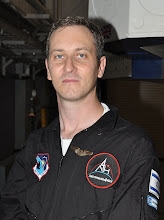One of the unexpected delights I had at the NSRC was lunch on Friday. Most of the attendees went to the hotel restaurant and formed a line. I ended up sharing a table with three men - Jin Kang, Gil Moore and Conrad Wall. If you know any one of them you now realize how lucky I was to be grouped with such interesting people.
Gil, the elder of the group became the natural chairman of our little lunch convention. It takes a great man, especially one who accomplished so much as Gil Moore, to listen more than talk. I must admit, though, that before that lunch I didn't know who Gil Moore was. Even before we sat down he wanted to hear our story and background. I told Gil and the others how I came about to attend NSRC, from my military service through the visit at Kennedy Space Center last fall and my Spacepirations blog (if you're new to Spacepirations, you may want to read my first post).
Jin Kang told us about his obligation as a Korean to go back to Korea to serve in the military, even though he lived in the United States. While in Korea, he got a PhD from Korea Aerospace University, and then returned to the USA. Late 2009 he became a teaching professor at Drexel university in Pennsylvania and is involved in CubeSat development. As an Israeli, I served in the military as most Israelis, but it was interesting to learn about Korean citizens having to go back to serve in the military, as Israelis living abroad don't have to come back to serve. Jin left an impression of being a very driven individual who sets goals and achieves them.
Conrad was an engineer of the Saturn rocket boosters during the Apollo program. After that he pursued a PhD in Bio-mechanical Engineering and is a professor at Harvard Medical School. He researches the inner ear and the effects of micro-gravity on it. In effect, he remained connected to the space domain and to me embodies one of the reasons we need a strong manned space program - medicine and medical advancements originally driven by space exploration end up benefiting Earth-bound people usually many times more than the astronauts for which they were developed for (examples can be found in this space-medicine page on Wikipedia).
 |
| Gil Moore |
No offense to Jin and Conrad, but it was most fascinating to listen to Gil Moore who was a part of the American space program from the days of the V-2 rocket launches. Gil told us how in 1947 he worked in White Sands Proving Ground (missile range) in New Mexico when V-2 rockets were brought to the U.S. after being captured from the Nazis. These rockets, developed by Wernher Von Braun and his team, were the direct basis for the American space program rockets like the Saturn, but by themselves were based on designs published by Robert H. Goddard, who is considered as the father of modern rocketry. Gil told us jokingly that the highest a V-2 flew was 131 miles and the lowest was a quarter of an inch, adding that it simply blew up... It was fascinating to hear about several of the projects and educational outreach Gil has been involved in over the years. Gil worked with 96 year old Lowell Randall, who worked with Goddard, and about 100 year old Joachim Kuettner, who flew a V-1 (I found another reference to this in an interview with Warren J. North).When Conrad and I left to catch the next lecture, Gil was engaged in a conversation with Jin, offering contacts and help. To hear more about rocket history from Gil Moore and Lowell Randall I recommend listening to broadcast 615 of The Space Show, where they were guests in 2006.
You never know when something as mundane as lunch will become an unexpected delight, and not because of the food. One has to be always receptive to opportunities as they present themselves. As luck stroke, I met three very interesting people and I really hope our paths will cross once more in the future, either through a job, convention or any other planned or random occasion.

 Space Shuttle Launch Poll Results
Space Shuttle Launch Poll Results













1 comment:
Way cool Amnon...I look forward to looking up in the sky and knowing you are up there.
Huge support,
The Rose's
Post a Comment